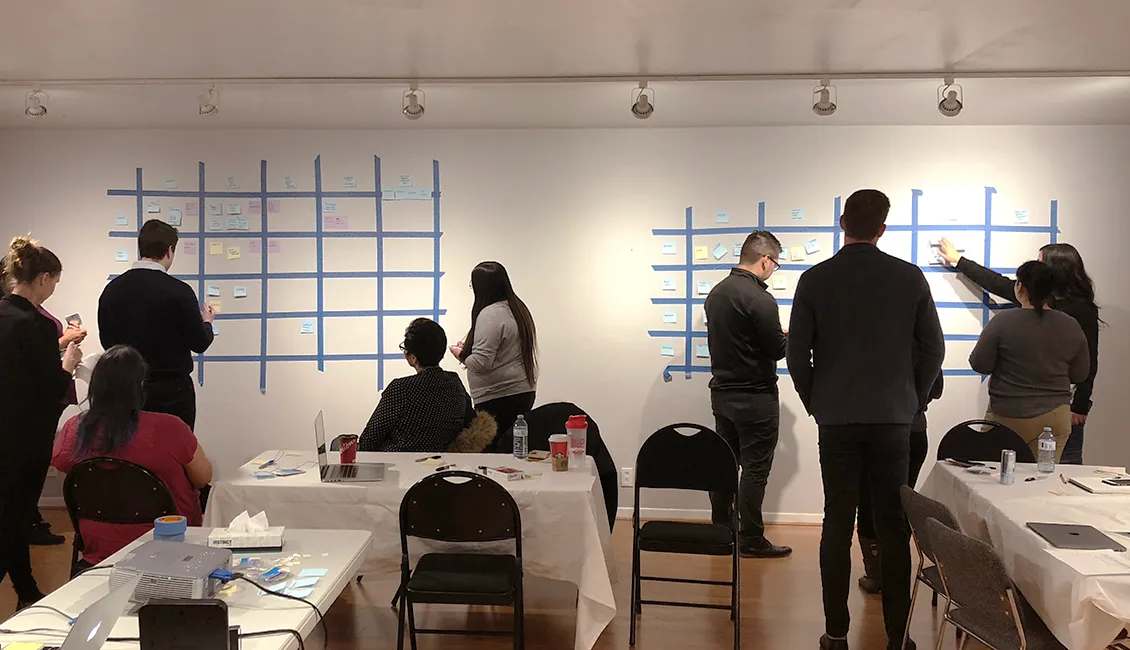Full Disclosure: We are believers, proponents and practitioners of Design Thinking. Because it works.
In looking at the state of disruption organizations face: the need to change, the challenge to innovate, to find a new vision; the insistence managers do more with less; the call to consolidate, to go digital, to integrate diverse services; to re-imagine the future and then make it real – well, those challenges probably explain that deer-in-the-headlights expression on the faces of many leaders I meet.
As most of our projects are software oriented, we are keen observers of the roadkill on the information highway. Those many species of fatality exhibited by innovation project failures. Those cost saving enterprise solutions that collapse in budget overruns. Shiny new applications that aren’t adopted because they are harder to use then what was replaced. The half successes that stop functioning from lack of support. Or, those projects that are enthusiastically and promptly built but are then re-engineered to add someone’s missed feature, and again for another’s missed capability, and again until their purpose has been forgotten and forward momentum stalled.
Then there are the digital pedestrians – the employees and end users – whose frustrations become a weak cynicism and wonderment at all the digital wheel spinning that seems to result in not much forward movement for them at all. And here comes the change management and training bus that follows in the dust of the efficiency producing projects that have made things less efficient for users. All with an increase in the corporate malaise.
What happened to those bright-eyed and bushy-tailed newbies? They joined the organization with the ideal of making a difference, only to get bogged down by the apathy of their co-workers, at least in regard to cycles of change and re-visioning driven from the top down.
I know there is a better way forward. We might be talking about a vast organization or a small team that needs change. The challenge may be identified or could be in a state of internal contention. It may even be a political football, with a huge public audience to take into account. “Strategic Visioning” has likely been tried before and failed to gain traction. Yet, there IS a way forward. And, the way to move forward in a productive way, to foster group cohesion and enthusiasm, to propel things forward is Design Thinking.
After building digital products and services for 20+ years, we know how to execute on successful projects, and it involves a user centered approach.
What is success in this context, anyway? We’d say it’s a few things. For the user, it means getting the thing they need – that thing that makes them better at what they’re trying to do – with little need for explanation or training in its use. For the purchaser, it means the process of attaining the new product or service went smoothly – that it was completed on time, on budget and with all parties agreeing they received what they were expecting, or more. And from zu’s point of view, the journey’s a success if the client is all revved up and ready to tackle the next challenge because of what their team accomplished, and how pleased their end users and bosses are.
If you are wondering what exactly goes on in these User Centered Design engagements, our own Design Thinking team can provide the details. Here, I want to jump straight to four of the key benefits that will be most helpful for decision makers stuck enroute to innovation.
Collaboration
People sometimes expect innovative ideas to come from consultants. Maybe. Sometimes. But, the innovation you need is already close at hand. It’s latent in the minds of your end users, the staff that works with them, and all of your team that touches the issue. Design thinking just surfaces it and pulls it all together.
When your team is guided through a Design Thinking engagement, it will go far, far beyond water-cooler discussions and inter-departmental meetings about the challenge. It’ll take your team past annual planning sessions, and certainly beyond the opinion of experts. This adventure of discovery will leave the silos of specialization in the rearview mirror, and the org. chart back at a rest stop.

Design Thinking goes all the way to the destinations of Trust, Creativity, and Unity of Purpose. Your project team has probably never made it this far before, has never really had to spend this much time together, listening to one another – comparing ideas and goals. Without the guided (and fun!) process of Design Thinking your team is unlikely to generate the collaborative results you need to succeed.
Insights
Whether these sessions start with examining where you’ve been – such as with findings from research, surveys, and interviews – or these sessions start with nothing: the process will generate insights. The Design Thinking approach consistently delivers an accurate and deep intuitive understanding of an issue or opportunity. These insights form the basis of breakthrough understandings and innovative approaches. The varied exercises of Design Thinking will coax all the tiny flakes of insight out of any cross-functional bunch of strangers or colleagues, gathering and melting them into a single compass needle of direction. The process is done once for initial problem identification, and once for choosing the best solution.
Success by any measure
Having the right direction makes getting to the destination so much easier. It also means your planned resources will be sufficient fuel for the distance you need to cover. Additionally, during the entire journey the Design team asks your team if they are still happy with where we’re headed. If they want to make adjustments, now is the time.
User Centered Design keeps a prototype of where you’re going front and center the whole trip. In most corporate trips, the destination is chosen for you. You’re taken there, dropped off, and trained to like it. Sometimes your company will need to pay for another trip to a different location after it’s apparent that the first destination was not suitable. With Design Thinking, the right direction leads to predictable costs, predictable arrival and assured satisfaction for the users.
User Centered Design is how one company’s free software beats another’s. It’s why you’re not using Yahoo for searches or Blackberries as your smartphone. It’s why folks like Uber better than taxis, though they are nearly the exact same thing. From the perspective of the user, the approach that wins was better. Solve the user challenge first and all other definitions of success follow.
The future
The last top reason organizations should use Design Thinking is that it makes people believe – as they used to – that they can make a difference. Most people want to improve things, to do more with their time, for things to run smoother, for clients to be happier, for the organization’s vision to be something they can truly stand behind. When I witness a client team emerging from the final session of a week long Google Sprint, it looks like they just finished an Outward Bound adventure. They are pumped and ready for more challenges. Outward Bound’s motto, incidentally, seems equally suitable for Design Thinking and is: “There is more in you than you think”.
Every organization will benefit when their employees are activated by the belief that effort and cooperation can produce change and improve things. Every organization should want their people to pitch in that discretionary personal effort that emerges when they are engaged. Nothing increasing engagement like an experience of success and a knowledge that they had a hand in choosing the direction forward.
So, when you need to define vision, build a brand from the ground up, or clarify a problem; when you are undertaking product, interface ,or software design; when you seek process improvement, or service design – we hope you remember these top 4 reasons to use Design Thinking.
